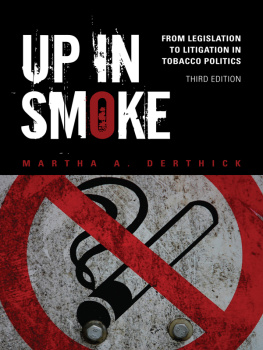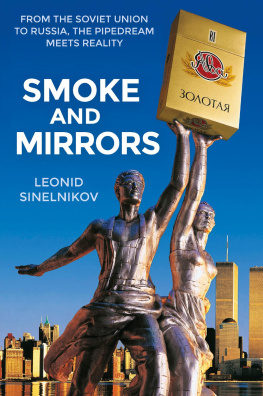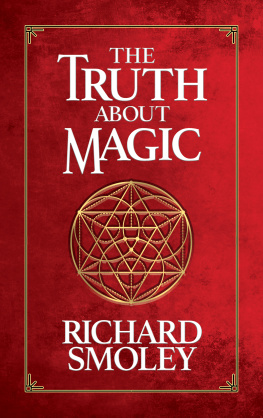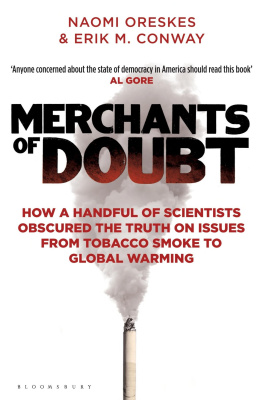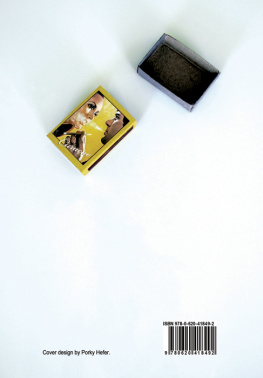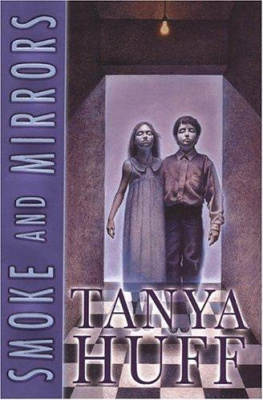Richard White - Smoke Screens: The Truth About Tobacco
Here you can read online Richard White - Smoke Screens: The Truth About Tobacco full text of the book (entire story) in english for free. Download pdf and epub, get meaning, cover and reviews about this ebook. year: 2010, genre: Politics. Description of the work, (preface) as well as reviews are available. Best literature library LitArk.com created for fans of good reading and offers a wide selection of genres:
Romance novel
Science fiction
Adventure
Detective
Science
History
Home and family
Prose
Art
Politics
Computer
Non-fiction
Religion
Business
Children
Humor
Choose a favorite category and find really read worthwhile books. Enjoy immersion in the world of imagination, feel the emotions of the characters or learn something new for yourself, make an fascinating discovery.
- Book:Smoke Screens: The Truth About Tobacco
- Author:
- Genre:
- Year:2010
- Rating:5 / 5
- Favourites:Add to favourites
- Your mark:
- 100
- 1
- 2
- 3
- 4
- 5
Smoke Screens: The Truth About Tobacco: summary, description and annotation
We offer to read an annotation, description, summary or preface (depends on what the author of the book "Smoke Screens: The Truth About Tobacco" wrote himself). If you haven't found the necessary information about the book — write in the comments, we will try to find it.
Smoke Screens: The Truth About Tobacco — read online for free the complete book (whole text) full work
Below is the text of the book, divided by pages. System saving the place of the last page read, allows you to conveniently read the book "Smoke Screens: The Truth About Tobacco" online for free, without having to search again every time where you left off. Put a bookmark, and you can go to the page where you finished reading at any time.
Font size:
Interval:
Bookmark:
Smoke Screens:
The Truth About Tobacco
Smoke Screens: The Truth About Tobacco
Copyright Richard White, 2009
The right of Richard White to be identified as the author of this work has been asserted in accordance with sections 77 and 78 of the Copyright, Designs and Patents Act 1988.
All Rights Reserved
No part of this publication may be reproduced or transmitted in any form or by any means, electronic or mechanical, including photocopying, recording, or by any information storage or retrieval system, without written permission from the author.
Whilst every effort has been made to contact the relevant copyright holders, if there is any missing information the author will be fully compliant with including it in future editions.
ISBN number: 978 1 4092 4670 1
A CIP catalogue record for this book is available from the British Library
Visit www.smokescreens.org to contact the author or for more information on Smoke Screens: The Truth About Tobacco including regular articles and a forum.
Published in collaboration with Lulu
3101 Hillsborough Street
Raleigh, NC, 27607
USA.
Printed in the USA
With thanks to:
Everyone who has offered support to this book being written and completed
Special Acknowledgements:
Linda Stewart, for her contributions to Chapter 6 with an article originally published as The Case Against Smoking Bans for N.Y.C. C.L.A.S.H.
Lauren Colby, for his continued support and contributions to this entire book
Dr Ian Dunbar, for the suggestions, contributions and support
Chris Snowdon, for the constructive criticism
Michael McFadden for his selfless help
Contents
Foreword by Dr Ian Dunbar vi
Introduction: Where it all began x
Chapter 1: The Black Lung Myth
Chapter 2: Chemicals In Tobacco
Chapter 3: Smoking and Socio-Economic Status (SES)
Chapter 4: Detection Bias
Chapter 5: Smoking and Cancer
- Animal Studies
- Human Studies
- Sir Richard Doll
- 1964 Surgeon Generals Report
- 2004 Surgeon Generals Report
- Ernst Wynder M.D
- Norwegian Study Examining Health Consequences of Smoking 87
- Native Americans and Smoking
- The Nazi Discovery of Smoking and Cancer
- Have Researchers Discovered How Smoking Causes Cancer?
- World Data
- Cancer and Genetics
Chapter 6: Passive Smoking 116
- Passive Smoking: A Political Issue
- Who Are The Anti-Tobacco Crusaders?
- Stanton Glantz 156
- Joe Cherner 161
- John Banzhaf 163
- James Repace 165
- 2006 Surgeon Generals Report
Chapter 7: Smoking and Emphysema 178
Chapter 8: Smoking and Heart Disease 184
Chapter 9: Smoking and Asthma 195
Chapter 10: Smoking and Low Birth Weight 202
Chapter 11: The Truth About Nicotine
Chapter 12: Government Health Warnings On Tobacco Products 215
Chapter 13: Health Benefits Of Smoking 218
- The Worlds Oldest People
Chapter 14: Past Attacks on Smoking 241
Chapter 15: The Pharmaceutical Connection 247
Chapter 16: The Cancer Research Institutes 256
- American Cancer Society (ACS) 263
- National Cancer Institute (NCI) 266
- Cancer Research UK 271
Summation 276
Appendix 1
Appendix 2 287
Appendix 3 288
Appendix 4
Foreword
It is a common student experience to be taught things one knows deep down are just not true.
In the 1950s, when Professor Richard Doll published his research linking smoking and lung cancer, I was a medical student. Everyone in the class scoffed. If smoking caused lung cancer why did so many smokers die of old age? Since those early days I have viewed each new statistical revelation with a pinch of salt.
In this conscientious, painstaking and scholarly review of the literature, Richard White has validated my scepticism. The book is encyclopaedic in its content. Among the many topics embraced is detection bias whereby the notion that smoking causes cancer is now so ingrained that the possibility of lung cancer when doctors examine non-smokers is overlooked; they are not expecting to find cancer and so do not investigate appropriately. Researchers still do not know precisely how, or indeed whether,smoking causes cancer or any of the other diseases attributed to it; they have struggled with weird and wonderful experiments to try and produce tumours in laboratory animals and failed dismally. The chemicals in tobacco smoke are similar to those in traffic fumes, except that in traffic fumes the concentration is much higher; cigarette smoke is therefore less toxic than the air we ordinarily breathe. In the final analysis, all that researchers have accomplished is to produce tenuous statistical links that they regard as significant. Examples of the disordered thought that has lain behind these tenuous links are also outlined.
Often forgotten is the fact that tobacco itself warns of its hazards. All smokers can recall that first puff that made them cough and splutter; indeed it made some vomit. The first lesson tobacco teaches is to take care when inhaling. Like all such experiences it is a question of moderation. Smoke too much for too long and the result is a smokers cough. But an excess of abstinence is equally hazardous; the fanaticism of the anti-smoking lobby graphically illustrates this.
The medical profession possesses more knowledge than one individual can master in a lifetime of learning. Professional organisation has evolved to cope by a division of labour into researchers, consultants and general practitioners. Researchers and consultants specialise in small areas of medical knowledge, studying in depth. General practitioners, on the other hand, acquire a more general knowledge of medicine, studying in breadth. Had they been better organised, researchers, consultants and general practitioners, working together as a team, could have made medical knowledge available to society both in depth and in perspective.
Unfortunately, researchers and consultants see themselves as superior and take a disparaging view of general clinical practice. In the National Health Service they routinely keep family doctors waiting weeks, even months, for a second opinion. But good family doctors really want that opinion by tomorrow. This is because they realise that their patients are anxious to know the result and seek to minimise that anxiety.
The General Medical Councils own rules regard disparagement as professional misconduct. But Council has routinely turned a blind eye so that professional misconduct has become institutionalised. The result is that the medical profession has lost all sense of proportion; researchers and consultants have no idea of the problems presenting in the family doctors consulting room from the world at large.
If one looks more closely at those problems, one finds that some 75% of cases are the physical symptoms of anxiety such as headaches, indigestion, diarrhoea, palpitations and general aches and pains. These symptoms mimic more serious physical illness and it is the clinical judgement of the family doctor that determines whether indigestion is caused by anxiety or cancer of the stomach, for example. About 24% of cases are minor infections such as coughs and sore throats. Serious physical illnesses of the kind described in medical text books, such as pneumonia, cancer and heart disease are very rare. Modern medical science is in fact totally ignorant of the causes and cures of most of the illness in the community. Over the years, ever more resources have been devoted to studying rarer and rarer conditions. But propaganda in the media would have people believe that medical science is on the brink of knowing it all.
There are two scientific methods: one is appropriate for studying inanimate objects like tobacco; the other is appropriate for studying animate objects such as people. The difference between them is that the study of inanimate objects excludes all reference to non-material or metaphysical states such as the mind. But to be scientific, all the variables affecting any given situation must be considered. Much of the confusion surrounding research into the effects of tobacco arises from the fact that a scientific method appropriate for studying inanimate objects such as tobacco has been deployed to study the effects of tobacco on animate objects such as people.
Next pageFont size:
Interval:
Bookmark:
Similar books «Smoke Screens: The Truth About Tobacco»
Look at similar books to Smoke Screens: The Truth About Tobacco. We have selected literature similar in name and meaning in the hope of providing readers with more options to find new, interesting, not yet read works.
Discussion, reviews of the book Smoke Screens: The Truth About Tobacco and just readers' own opinions. Leave your comments, write what you think about the work, its meaning or the main characters. Specify what exactly you liked and what you didn't like, and why you think so.








